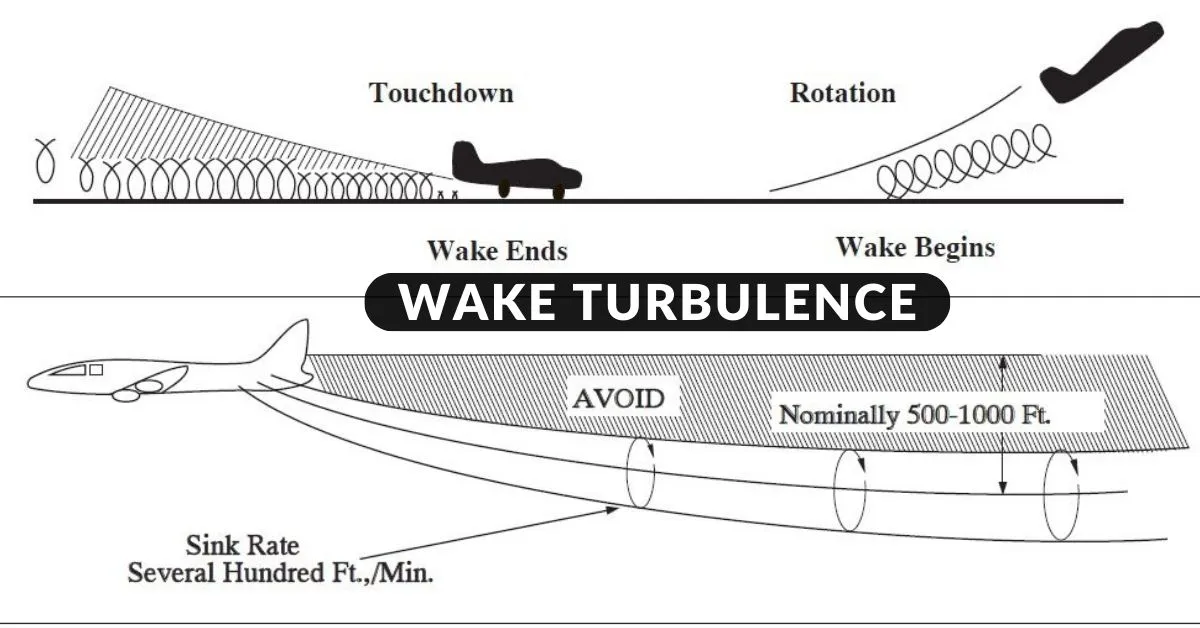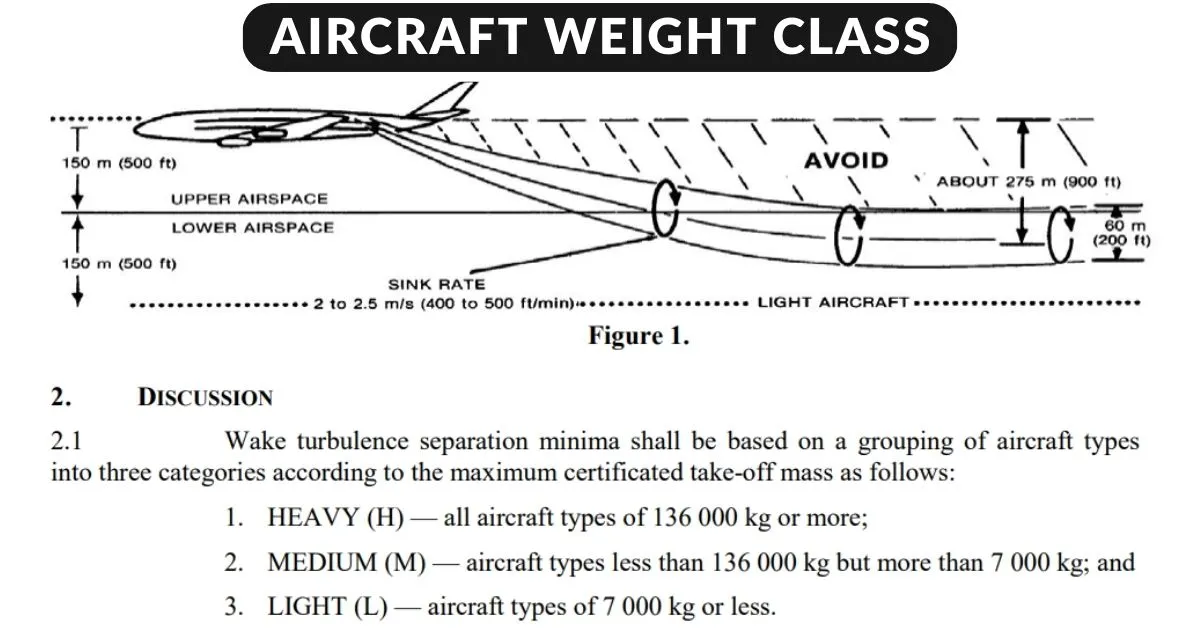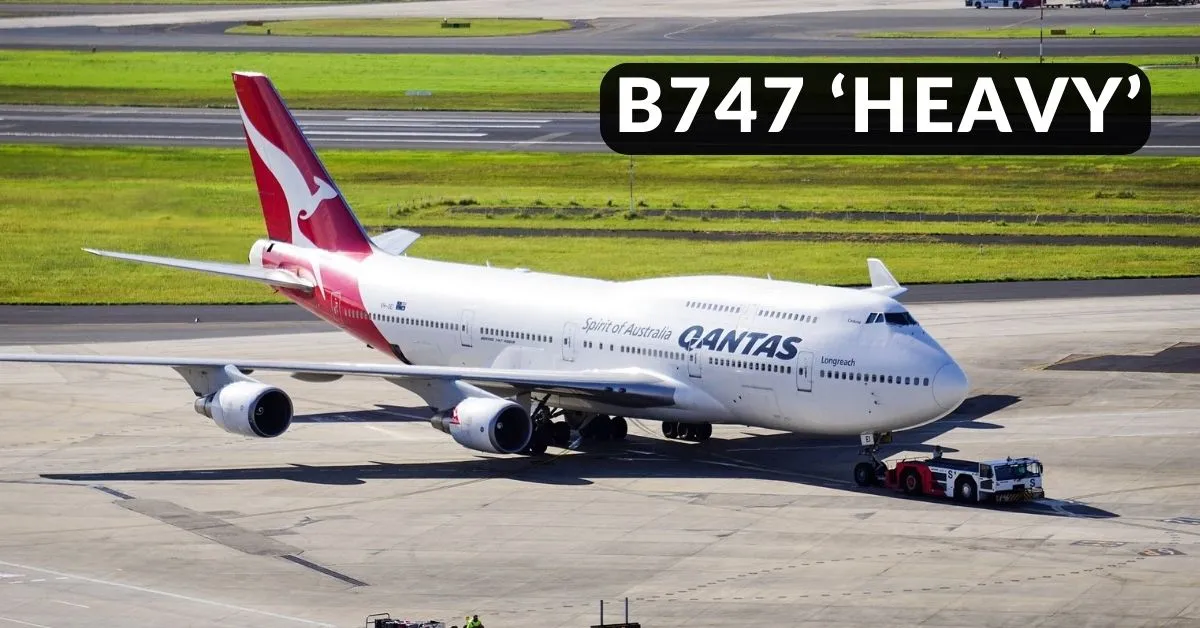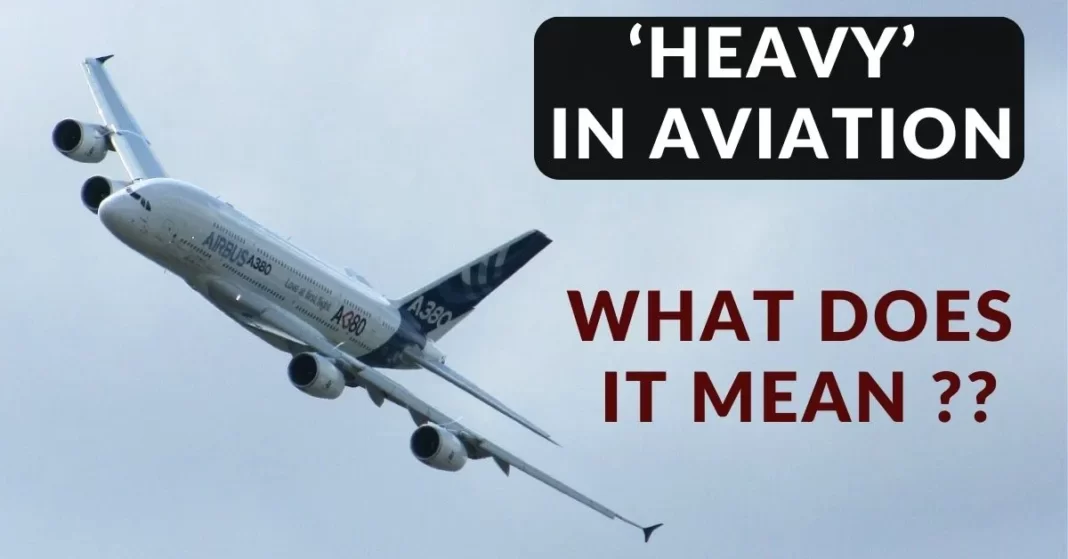In the world of aviation, there are various terminologies utilized to classify and identify aircraft. One such term is “heavy”. It’s not always synonymous with weight, as the terminology suggests, but signifies a contingency that is vital for safe operation within the aviation industry.
The title ‘Heavy’ is far more complex, influenced by a multitude of factors and guidelines set by global aviation regulators such as the International Civil Aviation Organization (ICAO). This blog will unravel the interpretation of ‘heavy’ in an aviation context, portray why particular aircraft receive the ‘Heavy’ designation, and finally, explore the real-life implications of this categorization.
Table of Contents
Knowing the term ‘Heavy’ in Aviation
In an aviation context, the term ‘heavy’ doesn’t necessarily refer to an aircraft’s physical weight. Instead, it’s used as an official International Civil Aviation Organization (ICAO) designation for any aircraft that is capable of taking off with a maximum weight of more than 255,000 pounds or 115,000 kilograms. This symbol is used in air traffic control communications for safety as it pertains to wake turbulence separation standards between aircraft.
Wake Turbulence and the ‘Heavy’ Designation

Wake turbulence is a disturbance in the atmosphere that forms behind an aircraft as it passes through the air. It is especially strong behind large aircraft, thus creating potential risks for smaller aircraft flying behind. The ‘heavy’ designation is critical for Air Traffic Control (ATC) to allow enough separation between a heavy aircraft and the aircraft flying behind to allow wake turbulence to dissipate, thus ensuring safe flying conditions.
Changes to the ‘Heavy’ Category in Aviation
Over time, as the industry has developed larger and more capable aircraft, new classifications have been added by the ICAO. The term ‘super’ is now used for the Airbus A380-800 and the Antonov An-225, which are larger than the typical ‘heavy’ aircraft. This designation is essential in creating even more distance behind these super aircraft to avoid potential issues with wake turbulence.
It’s also important to note that the Boeing 757, despite not meeting the weight threshold for ‘heavy’, requires the same separation for wake turbulence due to the strength of its wake. Therefore, ATC separates aircraft behind the 757 as they would for ‘heavy’ aircraft.
Importance of the ‘Heavy’ Designation in Aviation Safety
Understanding the term ‘heavy’ is crucial when it comes to aviation safety and flight operations. Its primary objective is to ensure a safe co-existence of various aircraft sizes in the sky by preventing any impact of wake turbulence. Controllers working in an Air Traffic Control (ATC) tower or pilots, be it commercial or private, must comprehend the implications and significance of ‘heavy’ in the aviation sphere.
Reasons for the ‘Heavy’ Designation
Here are the reasons for the ‘Heavy’ Designation in the aviation industry.
The Role of ‘Heavy’ in the Aviation Sector
The aviation industry assigns a very particular meaning to the term ‘heavy’, which goes hand in hand with strict regulation. As per the International Civil Aviation Organization’s (ICAO) specifications, an aircraft earns the ‘heavy’ label when its maximum takeoff weight exceeds 136,000 kilograms or approximately 300,000 pounds.
ICAO and Weight Classification
ICAO has set these weight classifications as part of its efforts to ensure the safety of all flights. An aircraft’s weight not only has implications for how it can be controlled in flight, but also the impact it has on surrounding air and other aircraft.

Heavier aircraft tend to produce stronger wake turbulence, which can pose a danger to other nearby aircraft. In order to allow air traffic control to maintain safe distances between heavy aircraft and those following them, the ‘heavy’ suffix is used in radio communication.
Aircraft Weight Class assigned by Federal Aviation Administration (FAA)
| CATEGORIES | AIRCRAFT TYPE |
| A | Heavy: Any aircraft weighing more than 255,000 lb such as the Boeing 747 or the Airbus A340 |
| B | B757: Boeing 757 all series |
| C | Large Jet: Large jet aircraft weighing more than 41,000 and up to 255,000 lbs such as the Boeing 737 or the Airbus A320 |
| D | Large Commuter: Large non-jet aircraft (such as the Aerospatiale/Alenia ATR-42 and the Saab SF 340), and small regional jets (such as the Bombardier Canadair Regional Jet), weighing more than 41,000 and up to 255,000 lbs |
| E | Medium: Small commuter aircraft including business jets weighing more than 12,500 up to 41,000 lbs such as the Embraer 120 or the Learjet 35 |
| F | Small: Small, single, or twin-engine aircraft weighing 12,500 lbs or less such as the Beech 90 or the Cessna Caravan |
Manufacturer’s Maximum Takeoff Weight
The maximum takeoff weight, or MTOW, is a limit set by the aircraft manufacturer, beyond which the aircraft is not built to safely take off. This weight includes not only the aircraft itself, but also its fuel, cargo, and passengers. When an aircraft is referred to as being heavy, it does not necessarily mean that it is carrying a large amount of weight at that specific time. Instead, the designation pertains to the maximum weight that the aircraft is capable of carrying safely.
Implications of the ‘Heavy’ Designation
Various factors can influence the maximum takeoff weight for a specific flight, including weather conditions, runway length, and even air traffic. In fact, a ‘heavy’ aircraft may sometimes be required to offload fuel or cargo to reduce weight under certain circumstances.
Additionally, heavy aircraft have to adhere to more stringent safety requirements. This includes keeping greater minimum distances from other aircraft, both in flight and on the ground, due to the stronger wake turbulence they generate.

Variations in ‘Heavy’ Classification
While the standard weight at which an aircraft is classified as heavy is universally recognized, there are also variations on this basic rule. For instance, in the U.S., any aircraft with a maximum takeoff weight of 255,000 kilograms (560,000 pounds) or more is referred to as a “super.” This term is primarily used to refer to the Airbus A380 and the Antonov An-225, the world’s largest aircraft by maximum takeoff weight. The term “super” is intended to alert air traffic control and other pilots to the even greater wake turbulence these aircraft produce.
The term ‘heavy’ is an integral part of the aviation industry as it plays a vital role in maintaining safety. This classification not only conveys an aircraft’s potential impact on its environment but also aids significantly in managing and controlling air traffic.
Implications of ‘Heavy’ on Air Traffic Control
Decoding ‘Heavy’ in Aviation
The ‘heavy’ label in aviation relates specifically to aircraft having a takeoff weight of 300,000 pounds or greater. The Federal Aviation Administration (FAA) in the United States utilizes this distinguishing label to sort aircraft. The main reason is the intense wake turbulence these large aircraft generate. To be precise, wake turbulence is an atmospheric disruption that forms in the wake of an aircraft, particularly during takeoff and landing at lower altitudes.
Implications of ‘Heavy’ for Air Traffic Control
Air Traffic Control (ATC) utilizes the ‘heavy’ designation for operational and safety reasons. Specifically, the label helps ATC manage the airspace around airports and maintain a safe distance between aircraft. This is due to the significant wake turbulence produced by aviation heavyweights, which can pose a risk to the following aircraft. Subsequent planes, especially smaller ones, need to maintain a greater separation distance to avoid the turbulence created by these heavy aircraft.
Safety Measures Associated with ‘Heavy’
To ensure safety, ATC adheres to specific traffic separation rules for ‘heavy’ aircraft. According to FAA regulations, when a heavy aircraft is leading, non-heavy aircraft must maintain a minimum separation of 5 nautical miles. Meanwhile, small aircraft, with a maximum takeoff weight of 41,000 pounds or less, are required to maintain a separation of 6 nautical miles when following a ‘heavy’. This allows for the dispersion of wake turbulence by the time the trailing aircraft reaches the same point in the sky.
Why do airline pilots say heavy?
It’s also crucial for pilots to understand the ‘heavy’ designation, as it plays an essential part in communications with ATC. Pilots flying ‘heavy’ aircraft are obligated to include ‘heavy’ in their radio transmittance to alert ATC and other aircraft about the potential for increased wake turbulence.
Further Classifications Beyond ‘Heavy’
Moreover, besides the ‘heavy’ designation, the FAA introduced another category known as ‘super,’ exclusive to the Airbus A380-800 and the Antonov An-225, given their enormous size and weight. This classification conveys an even higher level of caution due to the extreme wake turbulence these ‘super’ aircraft generate.
Introduction to ‘Heavy’ in Aviation
The term ‘heavy’ in aviation doesn’t simply denote the physical weight of an aircraft. Instead, it forms a critical part of the air traffic control language, which facilitates the maintenance of secure distances among aircraft to foster streamlined air traffic.
Real-world Examples and Effects
Digging Deeper into the Concept of ‘Heavy’
Within the aviation industry, ‘heavy’ signifies any large, wide-bodied aircraft that possesses a maximum takeoff weight exceeding 300,000 pounds. The Federal Aviation Administration (FAA) regulates these ‘heavy’ aircraft since they’re known to generate severe wake turbulence, a form of atmospheric disturbance that forms behind an aircraft as it moves through the air.
Given the possible risks associated with this turbulence, air traffic controllers purposely keep greater separation distances between ‘heavy’ aircraft and smaller ones for safety reasons.
Examples of ‘Heavy’ Aircraft
Real-life examples of heavy aircraft include popular passenger planes such as the Boeing 747, 777, and 787 as well as the Airbus A330, A340, and A380. Military transport aircraft like the Lockheed C-5 Galaxy and Boeing C-17 Globemaster III also qualify as ‘heavy’. Jumbo jets, too, are ‘heavy’ because they are wide-bodied, large-capacity aircraft with a maximum takeoff weight of over 300,000 pounds.
Effects of Wake Turbulence
Wake turbulence created by ‘heavy’ aircraft can have significant effects. Particularly critical during the landing and takeoff phases of flight, if smaller aircraft fly directly into the wake turbulence created by a heavy aircraft, they can experience violent and uncontrolled movements, which could potentially lead to crashes. Therefore, air traffic control must be extra cautious when scheduling takeoff and landings for these aircraft, ensuring a safe separation distance is maintained at all times.
Significant Incidents and Wake Turbulence
Historically, there have been incidents related to wakeup turbulence from heavy aircraft. One prominent example occurred in 2001, when an American Airlines flight crashed shortly after takeoff from JFK Airport. A smaller business jet hit the wake turbulence from the 747 that departed just before it, resulting in the loss of control and subsequent crash, killing everyone on board.
Evolution and Advances
Consequently, to counter the dangers posed by wake turbulence, several strategies have been introduced over the years. These include altering air traffic routes to avoid heavy aircraft, increasing separation between aircraft, and advising pilots about the dangers of wake turbulence.
Evolution and Advances
With advances in aviation technology, newer, more efficient ‘heavy’ aircraft are being designed which can produce less wake turbulence, thereby creating a safer aviation environment.
Furthermore, improved avionics and warning systems are being fitted into aircraft to assist pilots in identifying and avoiding areas of potential wake turbulence. Despite the inherent challenges, ‘heavy’ aircraft remain an integral part of global aviation, contributing significantly to both commercial and military operations.
Despite common misconceptions, the categorization ‘Heavy’ in aviation has less to do with an aircraft’s physical weight and more to do with its maximum takeoff weight and the inevitable wake turbulence it generates. Understanding this designation’s importance, and the safety measures taken as a result, gives one a profound respect for the intricate system that allows us to take to the skies.
The term not only helps in segregating traffic but also considerably mitigates risks of collisions, thereby ensuring a safer air travel experience. By looking at real-world examples, we can clearly see the impact of these ‘Heavy’ aircraft and the significance of carefully managing their wake turbulence.
Conclusion on ‘What does heavy mean in Aviation?’
In conclusion, the term “heavy” in aviation refers to an aircraft with a maximum takeoff weight of 300,000 pounds or more. This designation is important for air traffic control, as it helps them to ensure that heavy aircraft are given adequate separation from other aircraft.
Heavy aircraft also create more wake turbulence, which can be dangerous for smaller aircraft following behind. By using the term “heavy” in their radio calls, pilots help to keep everyone in the air safe.”





